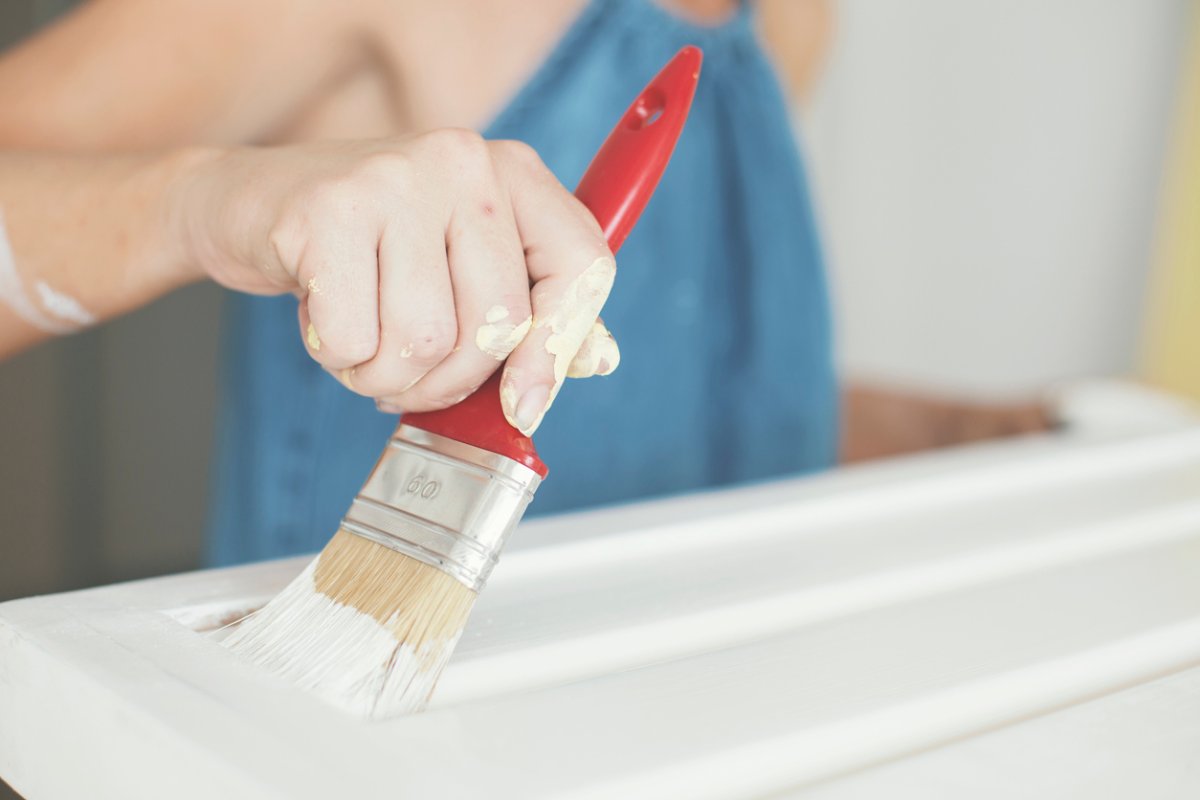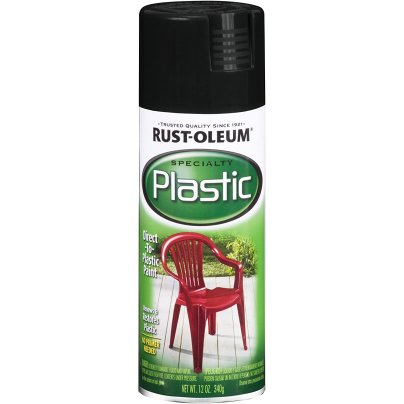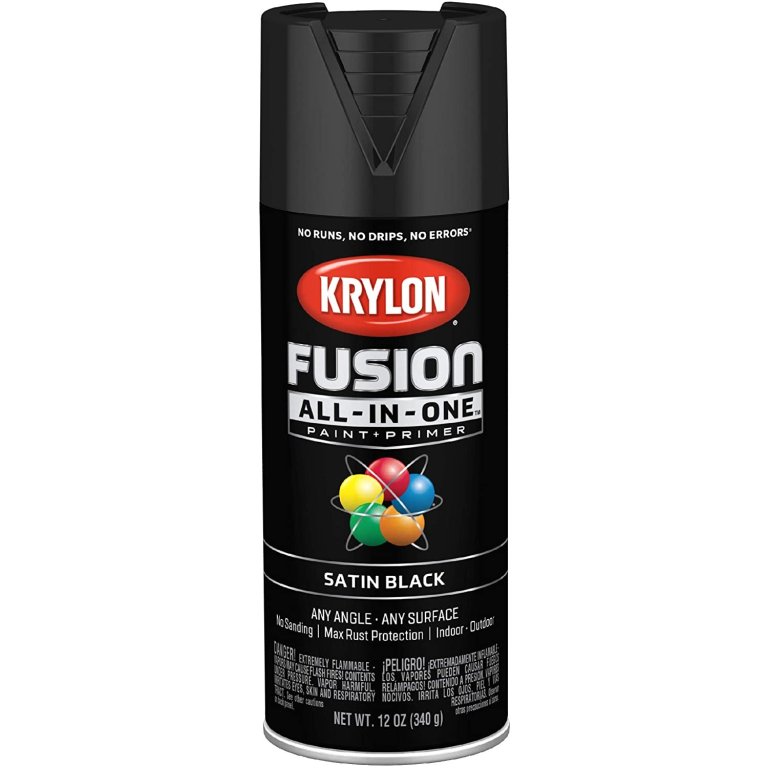
We may earn revenue from the products available on this page and participate in affiliate programs. Learn More ›
Nothing beats a fresh coat of paint in an attractive, new color to revive those dingy, faded, plastic objects around your house and yard. DIYers love to update inexpensive plastic items from thrift stores or dollar stores, transforming them into on-trend home decor.
For satisfactory results on your next plastic painting project, you’ll want to find a quality paint that’s formulated to cover plastic surfaces and learn the painting techniques and types of paint that yield good adhesion and a smooth finish on plastic.
Plastic can be a tricky surface to paint successfully, but modern paint products available on the market make painting plastic an easy job that offers pleasing results. With these paints, you’ll learn to love your plastic items again. Fortunately, this guide can help you find the best paint for plastic; read on for advice and recommendations.
- BEST OVERALL: Krylon Fusion For Plastic Aerosol Spray Paint
- BEST BANG FOR THE BUCK: Krylon Fusion All-in-One Spray Paint
- BEST OUTDOOR: Rust-Oleum Paint for Plastic Spray
- BEST FOR PLASTIC TOYS: Iris & Olivia Acrylic Paint Markers Set
- BEST FOR PLASTIC FENCE: Rust-Oleum Painter’s Touch 2X Ultra Cover
- BEST FOR AUTO PARTS: Rust-Oleum Automotive 11-Ounce Paint

What to Consider When Choosing the Best Paint for Plastic
If your next DIY project involves painting plastic, you’ll want to purchase high-quality paint for the job. Will your finished project be in a humid or a damp environment? Do you want a high-sheen finish or a matte finish? Is it a large job or a small job, requiring more or less paint? How long will it take for the paint to dry? These are considerations you’ll need to keep in mind as you shop for the best paint for plastic.
Quality of Paint
Paint is composed of four main ingredients: pigments, resins, solvents, and other additives. Pigments are fine particles that give paint its color and allow it to cover and adhere to a surface. Resins bind pigment particles together, and solvent is the carrier that binds resins and pigments. Other additives promote desirable qualities, such as resistance to mildew or scratches.
In high-quality paints, there are more pigments and resins with less solvent. When the paint dries and the solvent evaporates, you are left with a thicker, more durable surface.
Low-quality paints contain more solvents and fewer pigments and resins. The dried finish from low-quality paints is not as tough, and coverage is not as smooth and long-lasting.
Resistance to Moisture and Water
Kitchens and bathrooms tend to have more humidity and condensation than other areas of your home, so moisture-resistant paints are beneficial in these spaces. If you’re painting an item for outdoor use, you’ll want it to be water-resistant as well. Exposure to moisture and water can cause paint to crack and peel.
For high-moisture areas, choose paints that have a high sheen value, such as satin, gloss, and semi-gloss finishes. These paints dry to a hard finish that creates resistance to moisture. An additional bonus is that you can safely wash or scrub any satin or semi-gloss paint after it’s dried and cured.
Drying Time
When you’re spray-painting a plastic surface, the paint might feel dry to the touch in about 15 minutes, but you should allow for 30 minutes of drying time between coats. Paint dries best when the temperature is above 50 degrees and below 90 degrees. Make sure to provide good airflow and ventilation to aid in drying.
There is a difference between drying time and cure time. When paint is cured, it is 100 percent dry and has reached its maximum hardness. If you handle or use an object before the paint is cured, you can mar the surface of your newly-painted piece.
Check the product description or label information for the dry time and cure time of any paint that you plan to use.
Size of the Paint Can
The best way to paint plastic is with spray paint which is generally available in 12-ounce cans. A general rule is that 12 ounces of spray paint will cover 10 to 12 square feet of surface, but this is only an estimate.
Several factors influence how many 12-ounce cans of spray paint you’ll need for a project. Darker colors tend to require more paint than lighter colors to ensure good coverage. If you plan to paint a light color over a darker color, you’ll need more cans of spray paint. On the other hand, if you apply primer before painting your plastic-based project, it may require less paint for full coverage, depending on the color.
Material You Plan to Paint
In the past, plastic surfaces posed a problem for DIYers. Plastic is a tricky surface for adhesion, and paint may drip, smear, and chip. Today, several paint manufacturers offer paints that are specially formulated to provide solid adhesion and coverage with chip-resistant durability on plastic surfaces.
Spraying paint on your plastic surface provides the best coverage and leaves a smooth finish. It is possible to brush paint onto plastic, but it tends to smear, pool, and leave visible brush strokes. Priming the plastic surface before painting may make brushing more successful.
Before painting any plastic object, be sure the surface is clean and dry. With most spray paints that are formulated for plastic, you won’t need to sand or prime before painting.
Finish
Most spray paints formulated for plastic leave a gloss or a semi-gloss finish, but specialty finishes are available too. Metallic, hammered, textured, and camouflage finishes give new interest to old plastic items. Consider a specialty finish if you want to upcycle old plastic pieces to look like metal, stone, or other materials.
Metallic spray paints for plastic, feature colors such as gold, copper, nickel, bronze, and more. Hammered-finish spray paints are available in multiple color choices and leave a finish that resembles hammered metal.
Textured finishes in various colors may create the appearance of sand, stone, or metal. A camouflage finish transforms a surface into a variegated look in brown, green, khaki, or sand tones. Camouflage spray paint is especially useful for reviving your plastic hunting and sporting equipment.
Our Top Picks
Perk up your faded and worn plastic pieces―including patio furniture, fencing, toys, and automotive parts―with the best paint for plastic. The following recommendations suit a variety of indoor and outdoor applications, as well as budget considerations.
Best Overall
Krylon Fusion For Plastic Aerosol Spray Paint
Skip the sanding and priming steps when you use this spray paint from Krylon to revive your worn and faded plastic items. Each can contains 12 ounces of paint and features an EZ Touch spray tip to make your job quicker and easier. Apply several thin coats to achieve a smooth finish that resists chipping and scratching.
The paint is dry to the touch in 15 minutes and dry to handle in one hour. It’s fully cured and chip-resistant after seven days.
Fusion paint provides full coverage on most plastic surfaces, including PVC and resins. Because it was developed specifically for painting plastic, Krylon Fusion yields satisfactory and reliable results.
Best Bang For The Buck
Krylon Fusion All-in-One Spray Paint
Fusion All-in-One spray paint—also from Krylon—is a versatile product that’s suitable for painting plastic, wood, metal, PVC, and more. It yields a durable surface intended for both indoor or outdoor use. Sanding and priming are unnecessary because primer and color are blended together in this paint.
Easily paint awkward, hard-to-reach places with the specially-designed, big-button spray tip. You can even spray this paint while you’re holding the can upside down.
The paint is dry to the touch in 20 minutes and dry enough to handle in one hour. Spray on a second or third coat within two hours or after 48 hours. Krylon estimates that one 12-ounce can cover up to 25 square feet of surface area. Both changing your mind and changing your color preference are no problem when spray painting is this easy.
Best Outdoor
Rust-Oleum Paint for Plastic Spray
Plastic is an ideal material for outdoor items because it’s lightweight, durable, and resistant to rust, water, and weather. However, plastic surfaces do eventually fade and look worn after long-term exposure to sun and inclement weather. Perk up your plastic outdoor furniture pieces, mailboxes, and storage lockers with this plastic-specific spray paint from Rust-Oleum.
This oil-based paint is available in 12-ounce spray cans, and it’s recommended for multiple plastic surfaces, including PVC, resin, fiberglass, polypropylene, and more. For the most effective adhesion and coverage, you can spray the paint directly onto a clean and dry plastic surface without preliminary priming or sanding.
Each 12-ounce can covers up to 10 square feet, and the paint dries to the touch in about 20 minutes. The finish is a soft gloss with permanent color retention.
Best For Toys
Iris & Olivia Acrylic Paint Markers Set
Acrylic paint markers work on many surfaces—including plastic, wood, ceramic, glass, and metal—that are small in size. These acrylic paint markers from Iris & Olivia are non-toxic, odor-free, and acid-free, making them safe for use on children’s toys when you need to revive well-loved toys or label shared ones. They also provide permanent color coverage that is resistant to water and UV rays, so you can use them on outdoor and indoor items.
The set features 12 markers made from solvent-free Japanese acrylic paint ink in a rainbow of vivid colors. Acrylic paint markers give you the ability to paint toys and other small items that require precise detail. The highly-pigmented, fast-drying acrylic paint is water-based for easy cleanup.
Best For Plastic Fence
Rust-Oleum Painter’s Touch 2X Ultra Cover
Plastic fencing is popular because it doesn’t rot or rust, and it requires painting less often than wood. The downside is that exposure to moisture, weather, and the sun’s rays can take a toll on the appearance of a plastic fence.
Reinvigorate your plastic fence with this oil-based spray paint, also from Rust-Oleum. It dries to a hard, high-gloss finish that hides imperfections and creates a smooth, fresh look.
This paint is available at a reasonable price, and one 12-ounce can covers up to 12 square feet. If your plastic fence requires a lot of paint, the project will be within your budget.
Best For Auto Parts
Rust-Oleum Automotive 11-Ounce Paint
Rust-Oleum for the win again. Use this automotive spray paint for multiple surfaces, including automotive plastics, polypropylene, polystyrene, resin, PVC, and fiberglass. It’s available in 11-ounce spray cans.
The wide, comfortable spray tip is designed to help you avoid hand and arm fatigue with continuous spraying. It also allows you to apply paint at any angle, even when the can is upside down. This is especially handy when you’re trying to paint hard-to-reach auto parts.
Application is easy with no priming required. Simply remove loose dirt, wipe the surface clean, and let it dry thoroughly before applying the spray paint. The paint dries to the touch in 20 to 30 minutes and is completely dry in 24 hours.
Tips for Using Paint for Plastic
For upcycle and DIY projects like painting plastic lawn furniture or planter pots, spray painting yields the most satisfactory results. As you shop for spray paint, read product descriptions to verify that the paint is recommended for use on plastic surfaces.
If your project involves precise, detailed painting on plastic toys, miniatures, or models, you may want to explore acrylic paints in markers or 1/4-ounce bottles. Markers allow you to paint as if you’re holding a pen, or you can use a detailing brush to apply acrylic paint from small bottles. The following tips will help you to achieve a long-lasting coat when painting plastic objects:
- Be sure your surface is clean and dry before you begin painting.
- Work outdoors or in a well-ventilated area.
- Apply several thin coats, allowing recommended drying time between coats.
- If spray painting, cover the surrounding surfaces to protect them from overspray and hold the can 10 to 12 inches from the surface during application.
FAQs About the Best Paint for Plastic
With products specially formulated for painting plastic, you can infuse new life into old, faded, and discolored objects around your house and yard. The upcycling project ideas are endless for DIYers and casual home improvement buffs alike. Check out some of the most frequently asked questions and their informative answers to help you get started on your next painting project.
How do you spray paint plastic?
Use a spray paint that is intended for plastic, and apply several thin coats for full coverage without buildup.
What is the right kind of paint for outdoor plastic?
For outdoor plastic, you want reliable adhesion and resistance to moisture and mildew. Check product descriptions to discover which paints are formulated for outdoor plastic.
Does acrylic paint work on plastic?
Acrylic paint is suitable for small plastic miniatures, toys, and models. For durability, apply primer to your surface before painting, and finish the piece with a spray-on acrylic sealer.
Do you need to apply a primer when painting plastic?
Apply primer to plastic before painting with acrylic paint. Priming is not necessary when you use enamel or oil-based paint to coat plastic.









